By
Eric Vandenbroeck and co-workers
In a book released in
April (The Algebra of Warfare-Welfare: A Long View of India's 2014 Elections, Oxford
University Press) the authors describe Indian democracy as more like a spectacle of crass
majoritarianism where denial of justice to victims of the state-mediated
massacres - whether of the 1984 anti-Sikh riots, 1996 anti-landless massacres
(in Bihar's Bathani Tola and Laxmanpur
Bathe), 2002 anti-Muslim riots and many more - militates against any genuine
democracy. And that the "road shows" politicians organize during the
election periods show nothing except their own faces because actual challenges
ordinary people face largely remain concealed.
Below Narendra Modi during
his 2019 roadshow in Varanasi:
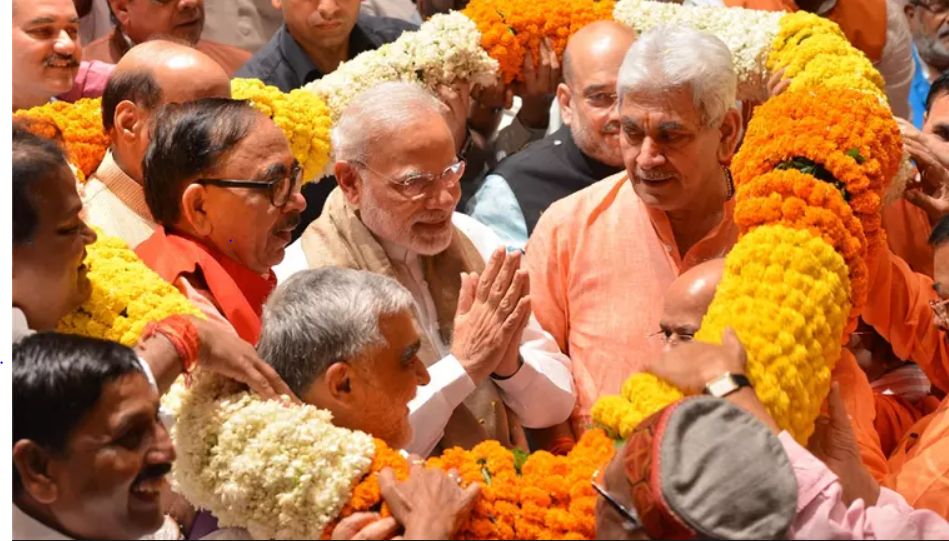
With below Modi that same
day in Varanasi performing the Hindu religious ritual called Ganga Aarti:
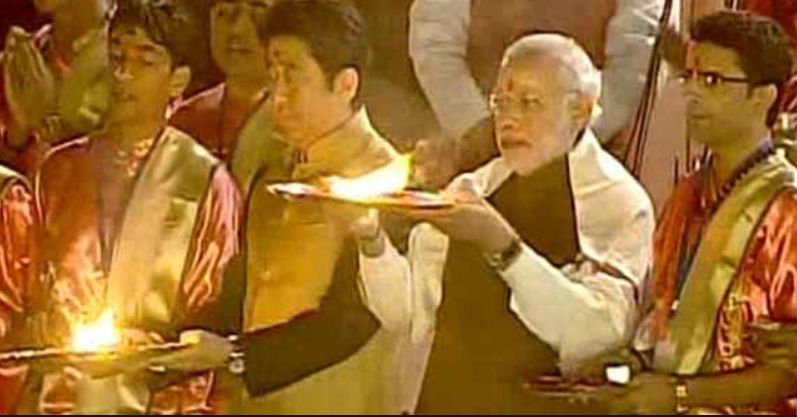
While I soon will
come to the Kumbha Mela (/ˌkʊmb ˈmeɪlə/)
it should be mentioned that Narendra Modi is a lifelong adherent of the Hindu
nationalist movement called Hindutva, and particularly his
closeness to the Rashtriya Swayamsevak Sangh (RSS).
The power of the secretive,
all-male Rashtriya Swayamsevak Sanghstretches
way beyond dusty villages and sprawling urban centers. More members of the
group, founded in 1925, are in the top ranks of government than ever before --
including India’s president and vice president, the head of the ruling party
and even Prime Minister Narendra Modi, who joined its children’s unit when he
was eight years old.
Underneath Volunteers of the Rashtriya
Swayamsevak Sangh (RSS) gather for a large-scale congregation in Meerut on Feb.
25, 2018. Photographer: Sajjad Hussain/AFP via Getty Images:
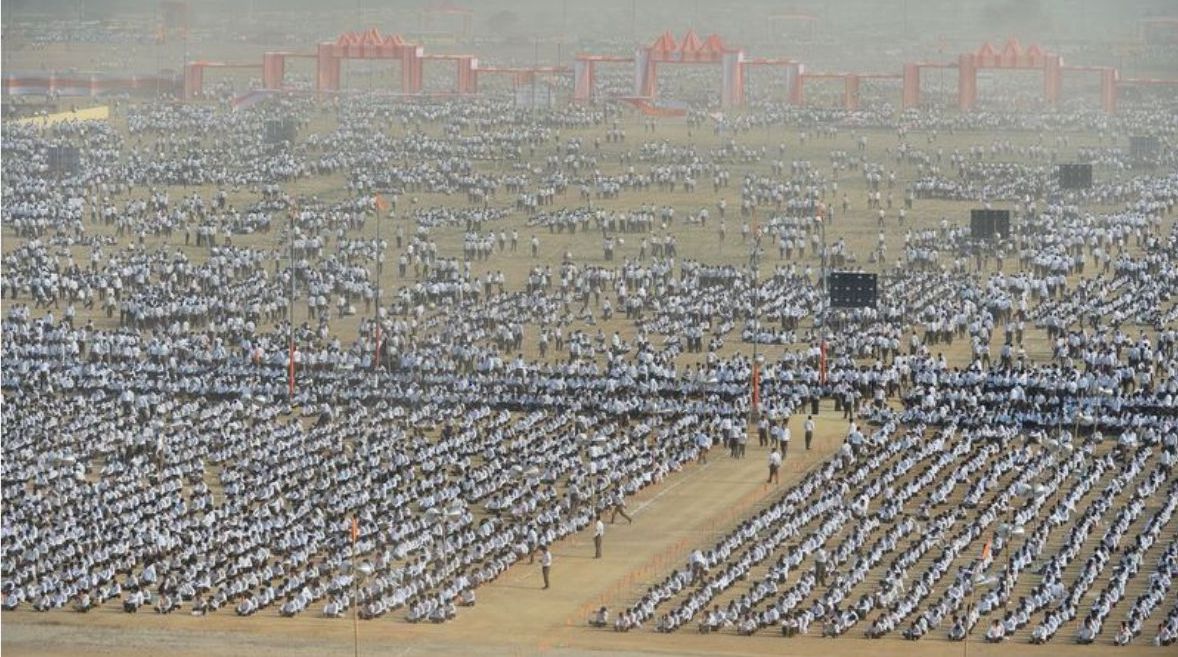
For nearly a century,
the RSS has sought to place itself at the center of the country’s policy-making
process. During Modi’s regime it has grown exponentially, with a 32 percent
rise in daily gatherings across the country, according to figures provided by
the organization.
This was also
illuminated by James Crabtree's 2018 book " The Billionaire Raj: A Journey
Through India's New Gilded Age" where during an interview with Crabtree
Modi's brother Prahlad the latter recalls that Modi started on his current path
as a full-time volunteer and lived in
the Ahmedabad headquarters of the RSS where he went "very deep into the
RSS and its works of nation-building and patriotism" and "decided to
dedicate his life to that."(1) Modi then set up a unit of the RSS’s
students’ wing, the Akhil Bharatiya Vidyarthi
Parishad, after which, Modi rose steadily in the RSS hierarchy, and his
association with the organization significantly benefited his subsequent
political career.
It is known of course
that the RSS has been banned several times since its inception in 1925, once
after a former member of the group assassinated independence hero Mahatma
Gandhi in 1948.That attack came after the RSS accused Gandhi of appeasing
Muslims at a time when Pakistan, an all-Muslim nation, was being carved out of
India. The ban was later lifted in the absence of any evidence the group
planned the attack.
According to Walter
K. Andersen and Shridhar D. Damle the RSS sought to draw upon the dense network
of mutts, ashrams and other organizations of monastic orders to develop
political Hinduism.(2)
A group of RSS pracharaks (which take four levels of training) act as the
core of the body, a vast network of prominent sadhus of various Hindu religious
sects formulate Hindu perspectives not just on social but also on political
issues.
In 1985 the RSS
assigned Modi to the BJP, when Modi rose to the rank of its General Secretary.
Modi then was appointed Chief Minister of Gujarat in 2001 where his
administration has been considered complicit in the 2002 Gujarat riots.
The turning point of
the dispute was the planting of an idol of an infant Ram in the Babri Masjid on
the night between December 22 and 23, 1949. It was this conversion of the
mosque into a temple that led to what initially was a legal battle.
By the time Modi was
appointed Chief Minister in 2001 Gujarat and had become a kind of laboratory
for the spread of BJP Hindu Nationalism where hard-line
Hindus called for the Babri mosque to be destroyed. It was built on the exact
spot in Ayodhya where Hindu faithful believe a Hindu god, Lord Ram, was born.
Some believe a Hindu temple stood there centuries earlier, though it's a matter
of debate among archaeologists.
In the late 1980s,
calls for the Babri mosque's destruction grew louder when Hindu nationalists -
those who believe India should be a Hindu nation - were gaining influence. Then
in 1992 RSS members were among those wielding hammers back in 1992 at the Babri
mosque. Footage from that
day shows mobs rampaging through Muslim homes and businesses in Ayodhya.
Even a decade later,
in 2002, the memory of the mosque's destruction remained so incendiary that a train
carrying Hindu pilgrims from Ayodhya came under attack in the Indian state
of Gujarat, sparking riots that left more than 1,000 people dead - most of them
Muslim.
Many blamed Modi for
doing little or nothing to stop the violence. (In 2005, Modi
was even denied a U.S. visa for this reason).
Senior Gujarat police
officer Sanjeev Bhatt has told the Supreme Court in an affidavit that chief
minister Narendra Modi had asked police officials to "let
Hindus vent out their anger against Muslims following the Sabarmati Express
train burning incident in Godhra on February 27, 2002".
Claiming that the
riots were systematically planned by a political party with the help of
criminal elements, Bhatt said, the riots could have been averted had timely
action been taken.
"Such things
(mass killing) will continue, unless and until we raise our voice. First 1993
riots in Mumbai, then the 2002 riots took place in Gujarat. If we keep quiet
now, then things will not change. If Muslims were killed now (in Godhra riots),
Hindus may be killed tomorrow," Bhatt said.
Shankar Menon, a
former bureaucrat of Maharashtra government, said, "When
I had spoke to the then deputy collector in Gujarat,
the collector told me that Modi had asked to take three Muslims lives for each
Hindu."
The relationship
between Modi and Hindu religious groups continued to be visible including also
during the 2013 Allahabad Kumbh or Kumbha Mela which was estimated to have been
visited by 120 million people when it strongly urged ascetics to communicate to
Hindus across the country that
supporting the BJP and Narendra Modi in the 2014 Lok Sabha elections was a
divine project.
Nilanjan Mukhopadhyay,
an expert in Hindu nationalist politics and author of a Modi
biography, said that the Kumbh Mela has always been used by right-wing
Hindu groups to promote religious polarization and mobilize support for issues
like the Ayodhya dispute.
What gave the 2013
Kumbh an extra frisson however was the image creation of Narendra Modi -- the
chief minister of Gujarat during the anti-Muslim carnage of 2002, who seemed
set to become the BJP’s prime ministerial candidate -- as the best choice for
political leadership in the country because he alone could ensure the success
of the divine project of Hindus.
According to recent
interview with Walter
Andersen, a professor of South Asia studies at Johns Hopkins University in
Washington, who has studied the right-wing group for over five decades and also
co-authored two books on the RSS, the organization now has unprecedented
influence across India. “On policy process, yes, it is much more active and
outspoken than ever before and that is because the affiliates have grown
rapidly and those affiliates have penetrated every aspect of Indian society,’’
Andersen said. Modi enjoys their support because they “have a measure of
influence in a BJP government to achieve what they want.’’
While the RSS
officially says it’s apolitical, volunteers work in their “individual capacity”
at polling booths to ensure maximum voter turnout for the ruling party. They
coordinate with millions of members from its 40 affiliated organizations,
including labor, student and education wings,
as well as another 500 social groups that want Modi to win again.
Thus during the 2019
Kumbh, Uttar Pradesh authorities set up temporary bridges, hundreds of mass
kitchens, more than 120,000 portable toilets, temporary power stations and
arranged thousands of free shuttle buses.
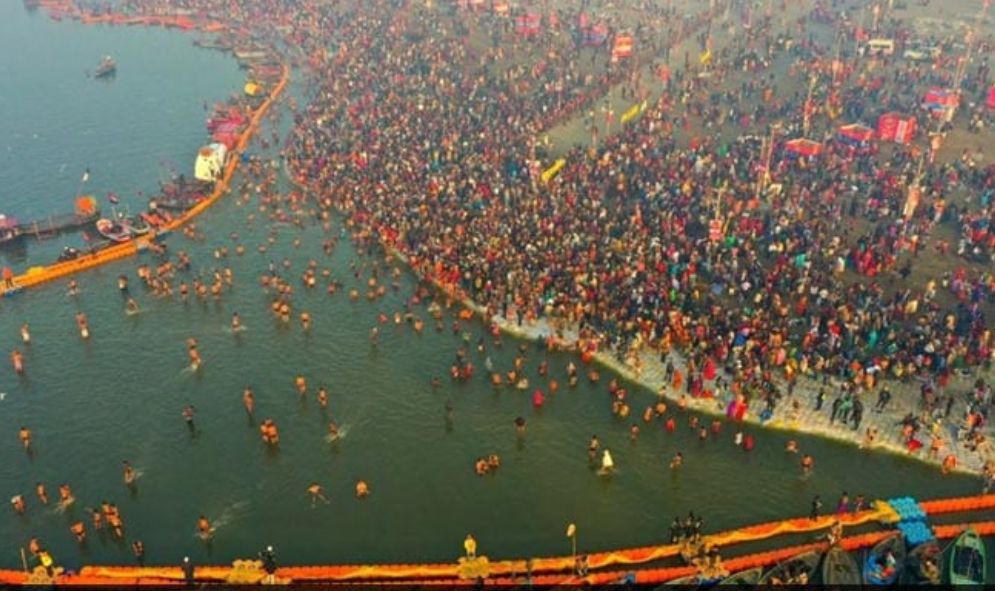
Images of Prime
Minister Narendra Modi and Uttar Pradesh Chief Minister Yogi Adityanath, the
two prominent poster boys of Hindutva, loomed large on giant billboards all
over the Mela area, while RSS workers roamed the grounds in groups, making the
religious congregation seem more like a party meeting rather than a fair of
sadhus and pilgrims.

It was nearly
impossible to take 20 steps along the pilgrimage route without passing a huge
sign featuring Mr. Modi’s face or the grinning visage of his close ally, Yogi
Adityanath, the monk turned chief minister of this state, Uttar Pradesh.
According to
Mukhopadhyay embellishing his image as a man of action, Modi likes to be
portrayed as a modern-day Vivekananda, a monk with a mission. In his words: “I
am not religious but I am definitely spiritual.” “Even now I have not
completely returned to the material world … I felt that if I have to do
something then I have to become part of some system, some structure.” Probed by
Mukhopadhyay about his role as a leader, he says: “I think it is probably a
god-gifted ability … Even I do not know how God gets me to do these things or
how I come to get these ideas.”
Behind his carefully
cultivated persona of sociability Modi is an undoubtedly astute operative. And
regardless of whether he continues forging his legacy for another five years,
there are crucial ways in which he has already permanently ‘Modi-fied’ India’s political landscape. Recent temple visits by
the INC president, Rahul Gandhi, in poll-bound states and the reluctance of
veteran liberal Shashi Tharoor to denounce gender segregation at a Kerala
temple demonstrate the frenzy into which Modi has spun his opponents. Insecure
as India’s conservative majority may be, it maintains a grasp on power which
makes it impossible to ignore.
First articulated in
Vinayak Damodar Savarkar’s seminal 1923 treatise “Hindutva: Who is a Hindu?”,
this world view holds that followers of Islam and Christianity cannot claim
equal membership in the Indian nation, and indeed pose an existential threat to
it, as their sacred sites lie elsewhere.
Many Indian liberals
supported Modi in 2014, hoping for decisive economic reform while turning a
blind eye to his Hindutva agenda. This time round, there can be no illusions
that a vote for the BJP is simply a vote for faster economic growth. Along with
the dream of a developed, prosperous India, the party seems to be grooming
voters for the sociopolitical ascendance of the militant Hindu nationalism that
cheered the destruction of the Babri mosque.
But it is crucial to
remember that since the 1980s, the Hindutva movement rode on a wave of evolving
media and technology as much as of democratic criticism against a liberal
democracy that acted in the interests of privileged elites (chießy
embodied by the Nehru-Gandhi family). Hindutva thus appropriated popular urges
for the democratization of an often self-serving and benevolent established
democracy.
The mainstreaming of
Hindutva ideology under Modi’s leadership has already changed India’s political
climate in fundamental ways. Now the country faces an existential question,
according to Shashi Tharoor, Congress party leader and author of the book Why I
Am a Hindu.
“Is India going to be
the India of the freedom struggle and the constitution, which sees every Indian
as equal irrespective of their religion, their region, their language, their
caste or any other marker of their identity from birth?” he asks. “Or is India
going to be redefined as an ethno-religious state in which Hindus will be seen
as the constituent elements of the nation, and all other minorities will be
here on sufferance, as guests or interlopers?”
Having now spent,
largely without interruption, almost a century violently working themselves
through India's diversity and democratic structures, they also have recruited
large numbers especially of young unemployed or underemployed men for the
"defense of Hinduism" in paramilitary groups such as the Bajrang Dal
(Hanuman's Force). Over the past few years they have also been trained in the
use of firearms. Modi and his professionally agitated supporters are thus if
that were to happen, not likely to take losses in these elections lightly.
On the day before the
final election is to take place, in a series of tweeted images, Modi, is seen
meditating while wrapped in an orange robe at a holy cave located at a famous
Himalayan pilgrimage site:
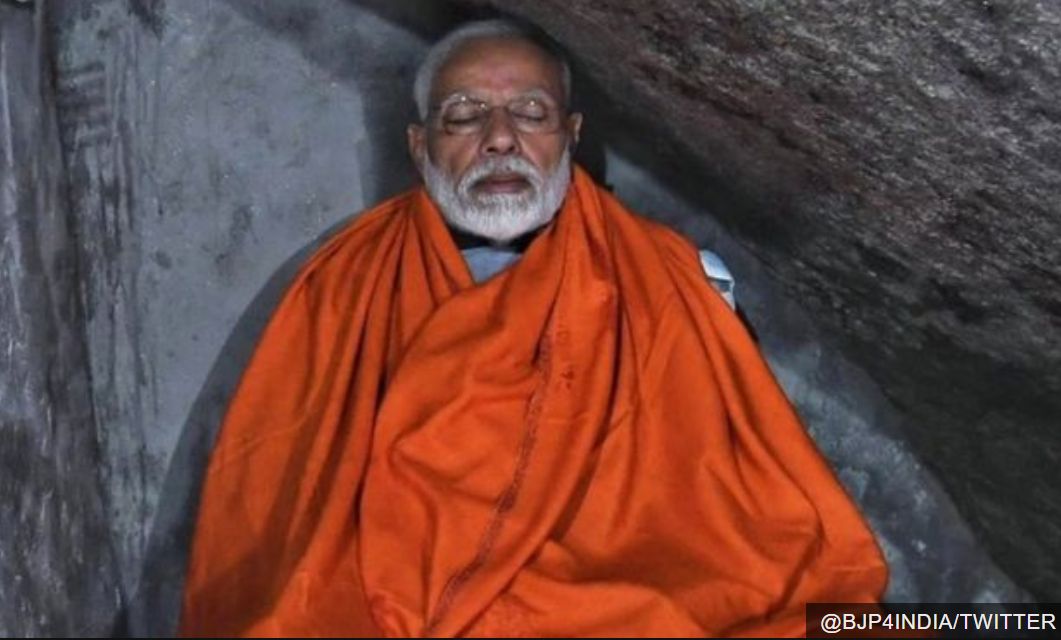
Thus tomorrow May 19,
will mark the final and seventh phase of this endurance test in democracy.
Voting will take place in eight states across 59 constituencies, with the
entire state of Punjab voting for the first and only time.
Another aspect of
Modi's ideology that I have not expanded on in the above article is illustrated
by an article last year titled: Blood
nationalism: Why does Hindutva perceive a mortal danger from the Aryan
Migration Theory?
In an 2 June 2018 article
I presented a factual overview of the current stand of research about the
alleged "Aryan migration theory" and the current stand of research as
to where the Indo-European languages came from.
1) James Crabtree,
The Billionaire Raj: A Journey Through India's New Gilded Age, 2008, p. 123
2) The Brotherhood in
Saffron. The Rashtriya Swayamsevak Sangh and Hindu
Revivalism, 1987, p. 133
For
updates click homepage here